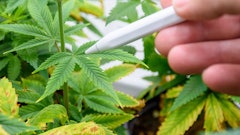
Editor's Note: This story was updated Jan. 15 with a correction. An earlier version of this story incorrectly stated hemp that tests above 1% THC will not be considered a negligent violation.
The U.S. Department of Agriculture has published its final rule on hemp, signaling what may be the start of an era of stability for an industry that has been in near-constant flux since its legalization in 2018—that is, if the new incoming administration decides to keep the regulations.
The final rule is set to take effect March 22 and replace the USDA’s interim final rule (IFR) on hemp, which was published Oct. 31, 2019.
“With the publication of this final rule, USDA brings to a close a full and transparent rule-making process that started with a hemp listening session in March 2019,” said USDA Marketing and Regulatory Programs Under Secretary Greg Ibach in a statement. “USDA staff have taken the information you have provided through three comment periods and from your experiences over a growing season to develop regulations that meet Congressional intent while providing a fair, consistent, science-based process for states, tribes and individual producers. USDA staff will continue to conduct education and outreach to help industry achieve compliance with the requirements.”
The rule’s 300 pages outline licensing requirements, recordkeeping requirements, procedures for testing tetrahydrocannabinol (THC) concentrations, procedures for disposing of non-compliant plants and more.
The THC limit for hemp remains at 0.3% despite at least hundreds—if not thousands—of comments on the IFR, as well as efforts by industry organizations, urging an increase to 1%. (Just one day prior to the USDA releasing its final rule, Kentucky lawmakers introduced a bill that would increase the allowable amount of THC in hemp to 1% in the state.)
However, Shawn Hauser, partner and chair of the Hemp and Cannabinoids Department at Vicente Sederberg LLP, says a number of improvements were made in the final rule based upon feedback received on the IFR during two separate comment periods. These include:
- an expanded harvest window time from 15 days to 30;
- alternative options for disposing of or remediating hemp that tests above the compliant THC level;
- an increased standard of negligence from 0.5% to 1% THC. This means hemp that tests above 0.3% but below 1% THC will not be considered a negligent violation, but it will still need to be disposed or remediated.
“The transition from prohibition to a legal and regulated system takes time, and USDA’s final rule is a historic step forward for hemp in the U.S.,” Hauser says in a statement. “…We are undoubtedly making progress, and we will continue to work with regulators and through Congress to perfect the regulatory structure for hemp.”
In 2020, the USDA announced the delay of some requirements outlined in the IFR, including the requirement for labs to be registered by the Drug Enforcement Administration (DEA) and the requirement that producers use DEA-registered law enforcement to dispose of non-compliant plants. Those delays have been further extended under the final rule until December 2022.
States operating under the 2014 Farm Bill will continue to be allowed to do so until Jan. 1, 2022.
Is the Final Rule Final?
Larry Farnsworth, spokesperson for the National Industrial Hemp Council (NIHC), says the organization is “pleased USDA has finally released their long-awaited rule on U.S. domestic hemp production and glad they listened to the concerns of the industry regarding sampling and testing.”
However, with President-Elect Joe Biden’s inauguration set for Jan. 20, Farnsworth predicts that the final rule may not be the end-all for federal hemp regulations.
“We anticipate, as is customary of new administrations, that this rule will be one of many that will be frozen on the first day of the Biden Administration,” Farnsworth tells Hemp Grower. “We look forward to working through these issues with the incoming Biden Administration and have all of this year to get it right before the 2014 authorities sunset.”


























